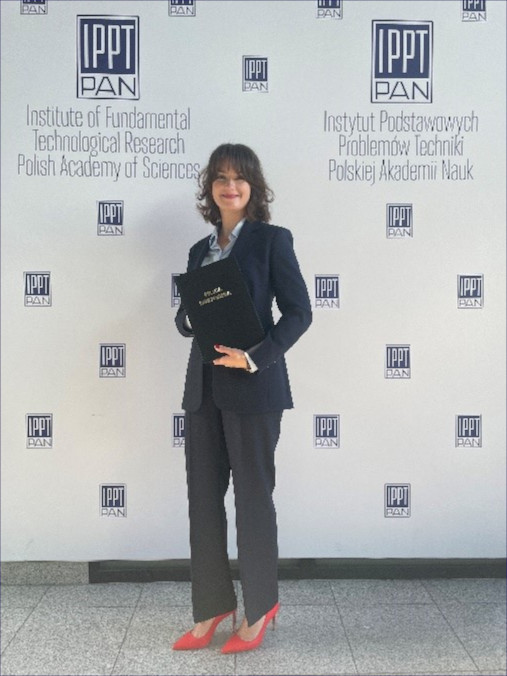
On 24 October 2024, according to the resolution of the Scientific Council of IPPT PAN, Agata Kaczmarczyk was awarded the degree of Doctor of Science in the field of Engineering and Technical Sciences in the discipline of Materials Engineering.
"Dependence of the properties of carbon nanoparticles synthesized and modified by laser ablation in liquid on the process parameters".
In recent years, carbon nanoparticles have attracted unflagging research interest due to their extraordinary optical, electrical and mechanical properties. Due to their biocompatibility, these materials may potentially replace the commonly used organic dyes and semiconductor quantum dots in fluorescent probes and sensors or biomedical imaging.
For both further research and potential applications of carbon nanoparticles, it is important to develop efficient synthesis methods to obtain nanoparticles with well-defined properties. One of the techniques is laser ablation of a graphite target immersed in a liquid.
However, there are certain ambiguities regarding the influence of laser ablation parameters on the properties of carbon nanoparticles. This issue constitutes a primary research problem, which is of fundamental importance for various applications of carbon nanoparticles. Hence, the motivation to undertake research was to address this concern.
The main aim of the dissertation was to associate the parameters of the laser beam, the phenomena accompanying ablation and the processes of nanoparticle formation. In addition, the aim of the work was to analyze the influence of the reagent (its type, amount and/or concentration) on the optical properties of carbon nanoparticles and to determine the ways of optimal surface functionalization as well as the kinetics and types of the occurring reactions. Moreover, the goal of the presented research was to determine the emission mechanism of carbon nanoparticles.
Three dissertation theses were formulated as follows. The first one stated the division of the synthesis process into two distinct stages, i.e. production and modification. The second thesis was related to the production stage and optimization of target ablation conditions to obtain nanoparticles of relatively small sizes. Thirdly, it was postulated that a small amount of reagent is sufficient for modification of optical properties of carbon nanoparticles.
The scope of work includes three parts. The first one describes the introduction, theses formulation and scope of the work. The second part of the dissertation was devoted to own experimental research, describing the research methodology and its results. In the last part of the dissertation, a summary of the results obtained in the work is presented.
In this work, a new synthesis method for obtaining carbon nanoparticles was developed. The first synthesis step was devoted to the ablation of a graphite target in water, whereas the second stage to the addition of a small amount of reagent without further modification of the suspension with a laser beam. This synthesis approach enables the control over the size, microstructure and optical properties of carbon nanoparticles.
The research results presented in the work allowed to prove formed theses. As it has been shown, the parameters of the ablation process should be selected in such a way to ensure that the temperature of the resulting plasma is as low as possible, while retaining maximum plasma pressure. To ensure low temperature during ablation, the process should be performed at low fluence values. Moreover, to ensure that the ablation mechanism is only thermal and to avoid undesirable effects such as crushing of the graphite target due to the recoil pressure, the optimum fluence value was estimated to be around 4 J/cm2. Using the estimated parameters, ablation of the graphite target in water was performed. The obtained suspension of carbon nanoparticles in water is characterized by a high degree of homogeneity - the obtained particles are spherical and have sizes in the range of 3-5 nm.
For the proposed form of the second stage of the synthesis, the observed change in the optical properties of the carbon nanoparticles suspension can only be attributed to the interaction between nanoparticles and functional groups of the reagent used. The analysis of the results showed that the emission mechanism of carbon nanoparticles is not related to the type of reagent used and, consequently, to the type of functional groups attached. On the example of the properties of mixtures of carbon nanoparticles and polyethyleneimine (PEI), it was proved that in the presence of a polymer, particle aggregation occurs and the emission intensity of the system increases. Thus, the concept of aggregation-induced emission mechanism was confirmed. It was shown that the process of particle aggregation in the presence of polymer is related to the electrostatic interaction between negatively charged carbon nanoparticles and PEI cations. The analysis of the modified models of adsorption kinetics showed that the emission change over time is controlled by the diffusion process. Hence, the transport of the reagent to the surface of the nanoparticles is diffusive in nature. Additionally, it was found that the optical properties of the mixture are determined by the first (rapid) stage of the diffusion process, where adsorption driving force is related to the electrostatic attraction between oppositely charged particles/molecules.















